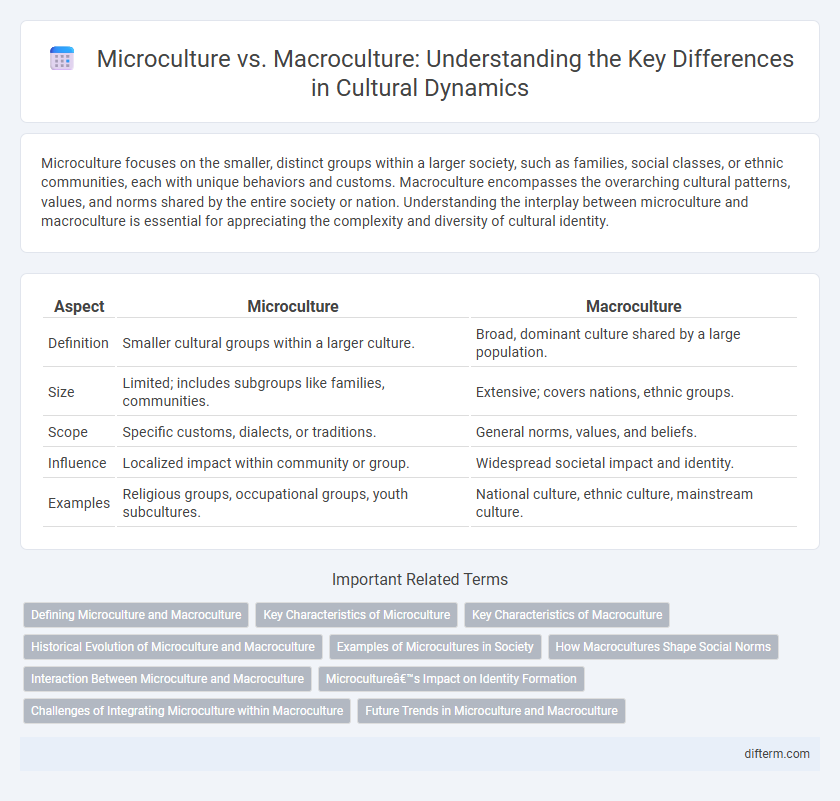Microculture focuses on the smaller, distinct groups within a larger society, such as families, social classes, or ethnic communities, each with unique behaviors and customs. Macroculture encompasses the overarching cultural patterns, values, and norms shared by the entire society or nation. Understanding the interplay between microculture and macroculture is essential for appreciating the complexity and diversity of cultural identity.
Table of Comparison
| Aspect | Microculture | Macroculture |
|---|---|---|
| Definition | Smaller cultural groups within a larger culture. | Broad, dominant culture shared by a large population. |
| Size | Limited; includes subgroups like families, communities. | Extensive; covers nations, ethnic groups. |
| Scope | Specific customs, dialects, or traditions. | General norms, values, and beliefs. |
| Influence | Localized impact within community or group. | Widespread societal impact and identity. |
| Examples | Religious groups, occupational groups, youth subcultures. | National culture, ethnic culture, mainstream culture. |
Defining Microculture and Macroculture
Microculture refers to the distinct cultural patterns, values, and practices shared by a small subgroup within a larger society, such as a family unit, workplace, or ethnic enclave. Macroculture encompasses the overarching cultural norms, beliefs, and institutions that characterize an entire society or nation, influencing broad social behavior and identity. Understanding the distinctions between microculture and macroculture reveals the dynamic interplay between localized cultural expressions and dominant societal frameworks.
Key Characteristics of Microculture
Microculture consists of distinct social groups within a larger culture, defined by shared behaviors, values, language, or interests that differentiate them from the macroculture. Key characteristics include unique norms, rituals, and communication styles that foster a strong sense of identity and belonging among members. These microcultures often emerge in settings such as workplaces, ethnic communities, or interest-based groups, influencing social dynamics and individual worldviews.
Key Characteristics of Macroculture
Macroculture encompasses the large-scale cultural framework shared by a majority within a society, including dominant values, norms, language, and institutions that provide social cohesion and identity. It influences broad social behaviors and political systems while often being reinforced through education, media, and government policies. The dynamic nature of macroculture allows it to adapt over time, reflecting historical changes and technological advancements.
Historical Evolution of Microculture and Macroculture
Microculture and macroculture have evolved distinctly through historical processes, where microcultures emerge from specific social groups, communities, or regions, reflecting unique traditions and shared experiences within a larger macrocultural framework. Macroculture represents the overarching cultural system that spans entire nations or civilizations, shaped by major historical events, technological advancements, and widespread social changes. Understanding the historical evolution of these layers reveals how localized microcultural identities persist and adapt alongside dominant macrocultural norms over time.
Examples of Microcultures in Society
Microcultures in society include groups such as college fraternities, fandom communities, and workplace cultures, each with distinct values, norms, and practices that differ from the broader macroculture. Ethnic neighborhoods and religious sects also represent microcultures, preserving unique traditions and languages within larger national contexts. These microcultures contribute to social diversity by fostering specialized identities and social cohesion among their members.
How Macrocultures Shape Social Norms
Macrocultures significantly influence social norms by establishing widespread values, beliefs, and behaviors that guide individuals across large populations. These dominant cultural frameworks provide a common ground for social interaction, shaping laws, traditions, and societal expectations. While microcultures may introduce variations and subcultural identities, the overarching impact of macrocultures ensures cohesion and predictability in social conduct.
Interaction Between Microculture and Macroculture
Microcultures shape individual identities and local behaviors within broader macrocultures, creating dynamic interactions that influence social norms and collective values. These interactions drive cultural adaptation and innovation by allowing diverse expressions to coexist and evolve within a unified societal framework. The reciprocal influence between microculture and macroculture enhances cultural complexity and fosters resilience in changing social environments.
Microculture’s Impact on Identity Formation
Microculture profoundly shapes individual identity by providing distinct values, behaviors, and social norms within smaller, close-knit groups, such as families, ethnic communities, or subcultures. These micro-level influences offer members a sense of belonging and uniqueness that contrasts with the broader, more generalized macrocultural frameworks. The interplay between microculture and macroculture ultimately contributes to a layered, dynamic construction of personal and social identity.
Challenges of Integrating Microculture within Macroculture
Integrating microculture within macroculture presents challenges such as identity dilution, communication barriers, and social exclusion, which hinder cohesive societal functioning. Power dynamics often marginalize microcultural groups, limiting their cultural expression and access to resources within the dominant macroculture. Effective integration requires policies promoting cultural recognition, inclusivity, and intercultural dialogue to balance diversity with social unity.
Future Trends in Microculture and Macroculture
Future trends in microculture emphasize hyper-personalized digital communities driven by AI algorithms, fostering niche interests and localized identities. Macroculture evolves through global connectivity, blending diverse traditions into hybrid norms while addressing challenges like cultural homogenization and sustainability. Emerging technologies and cross-cultural communication platforms accelerate these dynamic interactions, reshaping societal values and collective behaviors.
microculture vs macroculture Infographic

 difterm.com
difterm.com